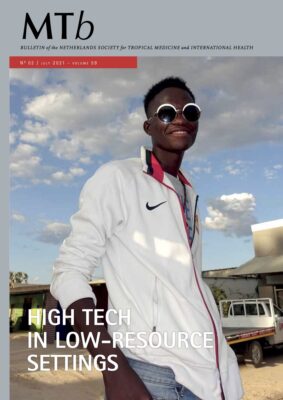
High Tech in Low-resource Settings
Editorial
High tech in low-resource settings and vice versa
Technology is changing fast, and many of the innovations developed and applied in other sectors have found their way to the field of medicine. Some examples include the use of m- and e-health in healthcare prevention and treatment, such as the application of mobile technology in the promotion of medication adherence, and ‘e-Estonia’ where in 2009 the country decided to fast track the use of electronic solutions in many sectors, most notably in the health sector. The Estonian nationwide Health Information System (EHIS) now contains all health data of every Estonian resident from birth to death, allowing each citizen and health provider to access an e-patient portal containing medical data, prescriptions and medical images. Besides the obvious direct practical uses, these data form the basis of many of the country’s health policies. Many of these technological advances enable more accurate diagnosis, including imaging. Though perhaps not novel, they may include redefining its original application, such as the use of ultrasound. Here, developments in high-income countries (HICs) and lowand middle-income countries (LMICs) run in parallel; simple protocols enable clinicians to do bedside ultrasound leaving the more difficult imaging to the radiologists, thus saving cost and time.[1] Another example of technology transfer is the use of 3-dimensional scanning and printing as a diagnostic tool or for replacing amputated limbs. On a similar note, laparoscopic surgery, which replaced open surgery in many surgical procedures in HICs, is being introduced in LMICs with obvious advantages such as speedy recovery, less blood loss and reduced need for anaesthesia. The list of technologies continues, including virtual reality labs, drone delivery of medical supplies, and the use of artificial intelligence to spot tumours.[2] The actual and potential use of such technologies is enormous; so are its (ethical) implications. As with non-technological solutions, there is the question of equitable access to these devices and techniques. According to the World Health Organization, the need for medical devices is the highest in LMICs, as they account for three quarters of premature deaths largely due to a lack of testing and monitoring equipment needed to screen for, diagnose and treat noncommunicable diseases.[3] Introducing new technologies is not only a matter of transferring knowledge. In drug development, for example, it requires creating a more diverse global bio bank – as less than 2% of genomic data represented in research is from African populations[4,5] – and developing business models that also work for LMICs. The latter requires removing financial hurdles to accessing biologicals (engineered monoclonal antibodies that target key steps in inflammation or cancer biology) for the treatment of infections and degenerative and auto-immune diseases. New initiatives are underway to make these expensive drugs available in LMICs. In this issue of MTb, we present some of these technologies. If you had thought the direction of these new developments is a one-way street from North to South, you are wrong. Tropical fruits such as pineapple and papaya contain enzymes that clean wounds and promote healing of e.g. burn wounds, providing a cheap, effective and safe solution. This technology has now successfully been transferred to HICs, where it has revolutionised burn care – reducing costs, blood transfusions and healing time. The potential of high tech for resourcelow settings is beyond imagination, overcoming difficulties in communication, long-distance travel, and expensive laboratory tests. Is it always by definition progress? It may well be(come), but only if we are willing to take the ‘white elephant’ lessons truly to heart.
Ed Zijlstra
Esther Jurgens



















































